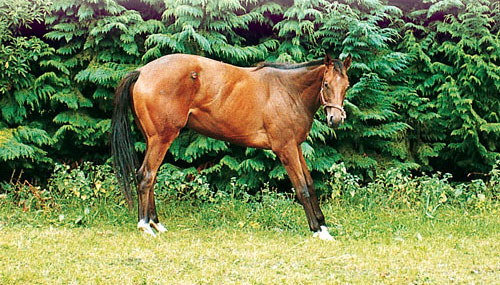


Definition:
Laminitis is a widespread, nonpurulent inflammation of the laminar corium that affects any hoof, but is usually more pronounced on the front hooves.
Course:
The ailment often develops within a few hours. But also a gradual, sometimes insidious process without obvious signs of lameness is possible.
Symptoms:
Bouts of severe sweating, muscular trembling and a stiff body posture with a painfully bent back. When standing, the horse positions its front legs forward and the rear legs under the body. Its gait is stiff. Especially turns give the horse obvious pain. Pronounced heel propulsion with alternately relieving the weight of the limbs. In severe cases it is impossible to coax the horse into moving. The body temperature may be raised up to 39°-40°C. Pulse and breathing rate are raised. The hooves are warm and painful to the touch when tapped or pressed with the hoof pincers. A swelling or depression may be visible on the coronet.
Treatment
The DALLMER Hoofshoe with raised heel plate and wadding enables the palmar angle to get back into the right position. Thus, it supports the frog and the sole and protects the horse from a sinking of the distal phalanx. When treating laminitis with DALLMER Rehe-Cuffs, the shoe’s outer wall always needs to be opened in the toeing area.
Aftertreatment:
Once the horse is without pain, step by step the heels can get lowered to their original position. After that, a laminitic horse can be optimally equipped with a DALLMER Hoofshoe with T-shaped steel inlay or a DALLMER Rehe-Cuff with a regeneration horseshoe. Contrary to regular horseshoes, DALLMER Hoofshoes don’t hinder the hoof’s natural widening but promote the regeneration after a laminitic phase.
Looking at a specimen model of a horse’s leg, Helmuth Dallmer realized that in a laminitic case a ruptured sole by the tip of the distal phalanx can be avoided if the deep flexor tendon is reliefed by raising the heels (by 2-3 cm), thus impeding a distal phalanx rotation or rather distal phalanx drop. Together with Prof. Bodo Hertsch, Helmuth Dallmer developed a method of treatment that is based on the raising of the heels. In doing so, for a while the horse wears glued-on DALLMER Hoofshoes with a raised wedge plate plus wadding. That way, the palmar angle regains a good figure, frog and sole are supported and a further sinking of the distal phalanx gets averted.
How DALLMER Hoofshoes prevent a sole rupture by the distal phalanx*
Physical effect of the raising of the heels on a horse’s hoof*
Always use x-ray photos when treating laminitis
Only by using x-ray photos all parameters can be taken into account to evaluate the severity of the disease: